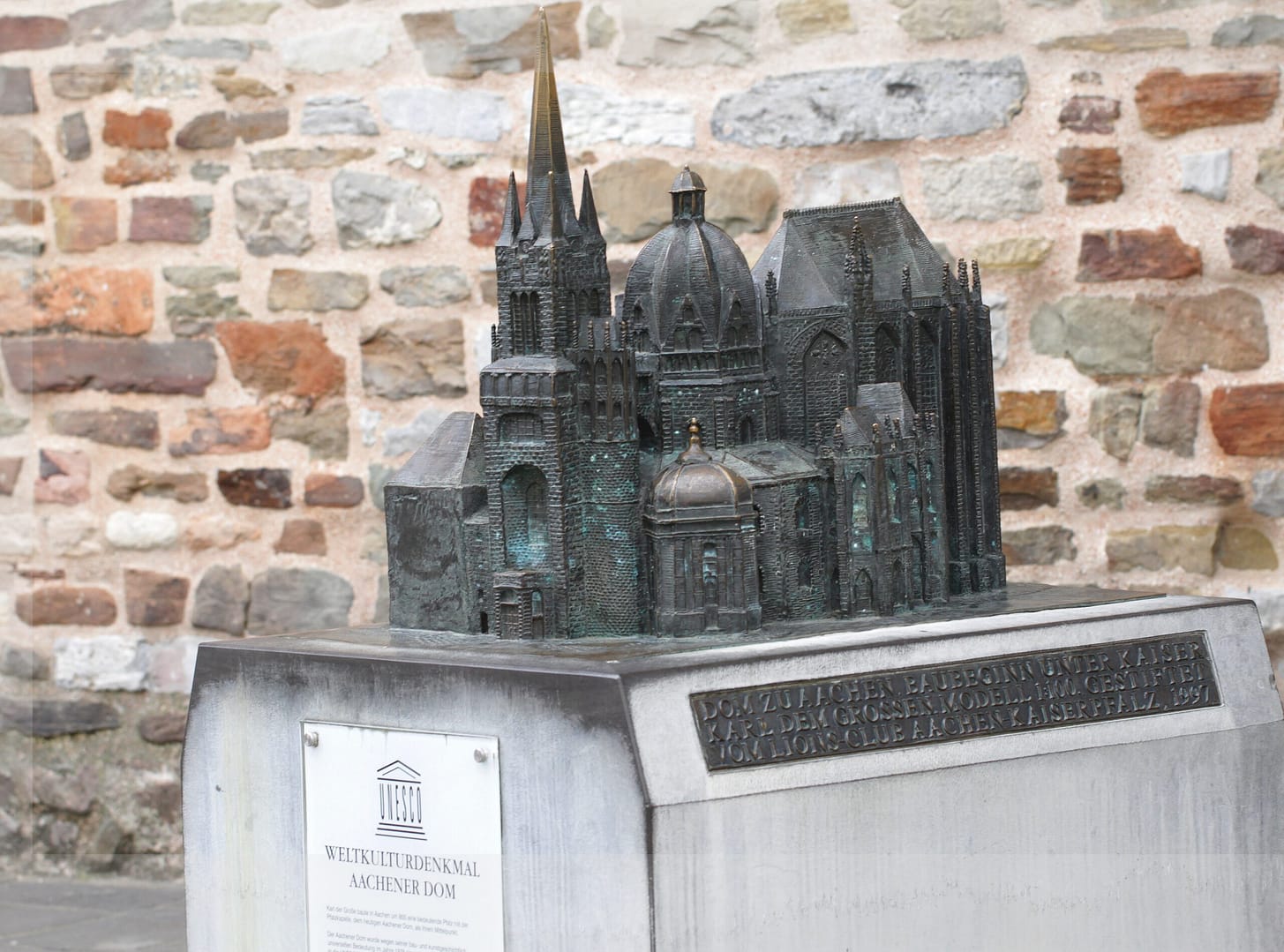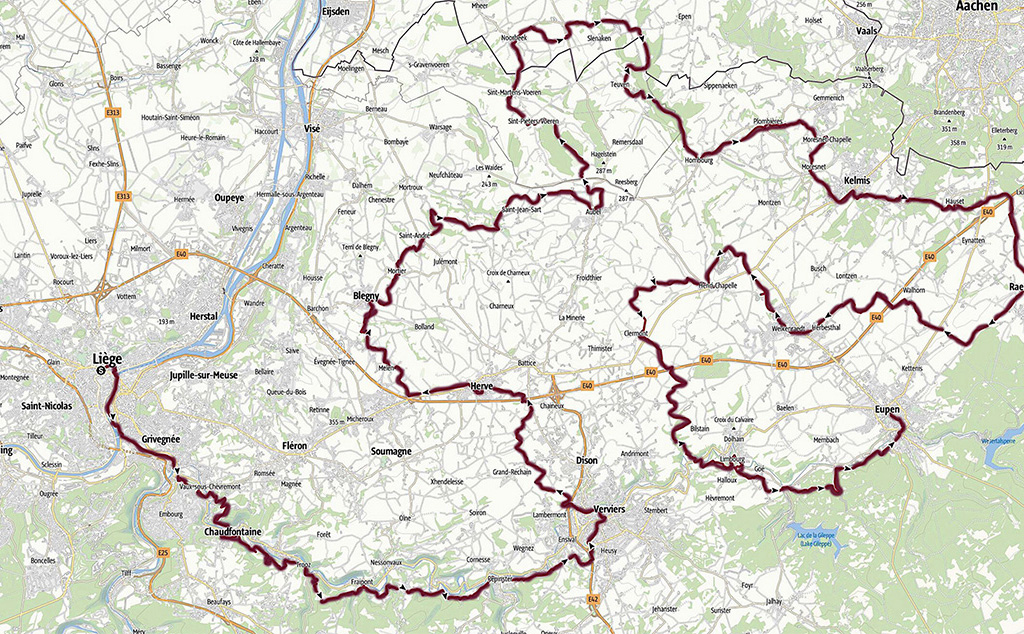In 44. etappes

Maastricht is the start of the Modern Grand Tour (MGT) and you follow a part of the Roman trade route Via Belgica.
Etappe 2. van Meerssen naar Spauwbeek

Meerssen was already inhabited during Roman times. In 1865, a priest discovered remnants of a Roman villa.

Spaubeek is a quiet village with a train station. Near the Sint-Laurentiuskerk is a large square where you can park for free.
Etappe 4.

Landgraaf naar Ü-Palenberg
Landgraaf is located in the province Limburg and is a young municipality in beautiful surroundings. And we think
Etappe 5.

Übach-Palenberg to Jabeek
Übach-Palenberg is located 20 km of Aachen at the frontier with the Netherlands. Club life is very important.
Etappe 6.

Jabeek to Born
Jabeek is a small residential area in Beekdaelen. The name is probably derived from the stream Quabeek. dfw
Etappe 7.

Born to Opglabeek
Born dates from the year 1125. The settlement Born arose on the northeast side of the Graetbos near a water source.
Etappe 8.

Opglabeek to Genk
Opglabbeek inhabitants lived from agriculture and turf extraction at the end of the 18th century.
Etappe 9.

Genk naar Hasselt
Genk is a cosmopolitan city in the Belgian province Limburg with more than 66,000 inhabitants.
Etappe 10.

Hasselt to Wintershoven
Hasselt arose in the 7th century near the Helbeek. The name is probarly derived from Hasaluth, which means.
Etappe 11.

Wintershoven to Tongeren
Wintershoven is located at Roman main road to Tongeren. Roman roof tiles were used for the Sint-Pietersbandenkerk.
Etappe 12.

Tongeren to Liège
Tongeren is the oldest city in Belgium. Famous inhabitant of Tongeren is undoubtedly the Eburone king Ambiorix.
Etappe 13.

Liège to Chaudfontaine
Liège is located at the river Meuse. Romans inhabited Liège in the center of of the city at Place Saint-Lambert.
Etappe 14.

Chaudfontaine to Pepinster
Chaudfontaine is a town on the river Vesder in the province of Liège. The place has given its name to the spring.
Etappe 15.

Pepinster to Herve
Pepinster traditionally had many watermills, due to its location between two fast-flowing rain rivers.
Etappe 16.

Herve to Aubel
Herve gave its name to the surrounding. The Land of Herve are villages that stretches between Meuse and Vesder.
Etappe 17.

Aubel to Fouron-Saint-Martin
Aubel is known for its regional products: Herve cheese, syrup, cider and beer. These are traded on the markets.
Etappe 18.

Sint-Martens-Voeren to Teuven
Fouron-Saint-Martin is located in the valley of the Voer. After the French period, this village became Belgian.
Etappe 19.

Teuven to Calamine
Teuven mains income was agriculture. In 1850 the conversion to farming began. There is no industry.
Etappe 20.

Kelmis to Raeren
Kelmis (La Calamine) is located at the frontier between Belgium and is grown around the Altenberg zinc mine.
Etappe 21.

Raeren to Henri-Chapelle
Raeren is a German-speaking city in the province of Liège in Belgium and has more than 10,000 inhabitants.
Etappe 22.

Henri-Chapelle to Limbourg
Henri-Chapelle is a Belgian village in the province of Liège. Located 17 kilometers from the frontier of Aachen.
Etappe 23.

Limbourg to Eupen
Limbourg was founded in the year 1000. The city had a reputation for being impregnable and strategic of great.
Etappe 24.

Eupen to Eupen
Eupen is the capital of East Belgium in the province of Liège and at the frontier of Nature Reserve Hautes Fagnes.
Stage 25.

Eupen to Jalhay
Eupen is the capital of East Belgium in the province of Liège and at the frontier of Nature Reserve Hautes Fagnes.
Stage 26.

Jalhay to Spa
Jalhay is located at the Nature Reserve Hautes Fagnes and has countless possibilities for walks in the.
Stage 27.

Spa to Hockai
Spa is located in the province of Liège. The thermal baths of Spa are listed as UNESCO World Heritage.
Etappe 28.

Hockai to Signal de Botrange
Hockai is one of the highest villages of Belgium and situated in the far north of Stavelot in the province of Liège.
Etappe 29.

Signal de Botrange to Butgenbach
Try to climb the stairs of the monument an, you can even reach above 700 meters.
Etappe 30.

Butgenbach to Hellental
Bütgenbach is located in the German-speaking of Belgium. In 1932 a dam was built and Lake Bütgenbach was created.
Etappe 31.

Hellental to Monschau
Hellenthal is located on the edge of the Eifel National Park and the Oleftalsperre is one of the largest reservoirs in Germany.
Etappe 32.

Monschau to Einruhr
Monschau is located in the most beautiful regions of Germany; the Eifel. Monschau was first mentioned in 1198 as Mons Ioci.
Etappe 33.

Einruhr to Heimbach
Einruhr is at the eastern bank of Rurtalsperre Schwammenauel and part of the municipality of Dedenborn.
Etappe 34.

Heimbach to Woffelsbach
Heimbach; the towers of Hengebach castle reigns over over the valley. The first mention of Heimbach was in 673.
Etappe 35.

Woffelsbach to Simonskall
Woffelsbach the village is located in the northern Eifel at the banks of the lake Rur, that flows into the river Meuse (NL).
Etappe 36.

Simonskall to Breinig
Simonskall started as a small settlement with the presence of iron ore, especially around the village Schmidt.
Etappe 37.

Breinig to Stolberg
Breinig is today characterised by its urban value and the careful preservation of its historic buildings.
Etappe 38.

Stolberg to Aachen
Stolberg is a historic old town with an impressive castle complex, three old town and pre-industrial homes.
Etappe 39.

Aachen to Epen
Aachen is founded on the remains of Roman baths. The Latin word aqua can be taken as the origin of the name.
Etappe 40.

Epen to Simpelveld
Epen is probably derived from a Germanic word of possibly Celtic origin,
Etappe 41.

Simpelveld to Valkenburg a/d Geul
In 1930 some sandstone coffins from the Roman era were excavated.
Etappe 42.

Valkenburg a/d Geul to Margraten
Around the 19th century tourism developed as a new source of income.
Etappe 43.

Margraten to Eijsden
Margraten is international known by the presence of the Netherlands American Cemetery and Memorial, a large military cemetery.
Etappe 44.

Eijsden to Maastricht
Eijsden lies on the frontier with Belgium and on the banks of the river Meuse in the extreme southwest of the Dutch region Zuid-Limburg.
The Modern Grand Tour trail in 4. sections:
Eupen (BE) to Aachen/Aix-la-Chapelle (DE); the western most major city in Germany.
Total length 312 km.
[maxbutton id=”48″]
Aachen/Aix-la-Chapelle (DE); the western most major city in Germany to Maastricht (NL).
Total length 138 km.
[maxbutton id=”49″]





